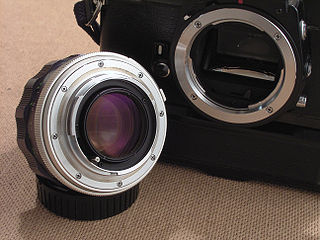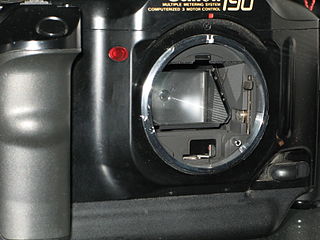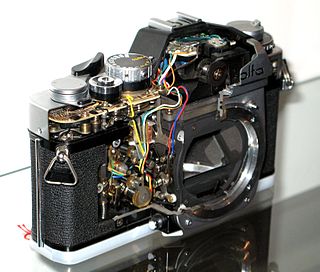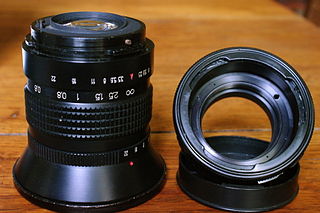Related Research Articles

The Nikon F camera, introduced in April 1959, was Nikon's first SLR camera. It was one of the most advanced cameras of its day. Although many of the concepts had already been introduced elsewhere, it was revolutionary in that it was the first to combine them all in one camera. It was produced until October 1973 and was replaced by the Nikon F2. Aspects of its design remain in all of Nikon's subsequent SLR cameras, through the current Nikon F6 film and Nikon D6 digital models. The "F" in Nikon F was selected from the term "re-f-lex", since the pronunciation of the first letter "R" is not available in many Asian languages. That tradition was carried all the way through their top line of Nikon cameras until the introduction of the Nikon D1 (digital) cameras decades later.

The EF lens mount is the standard lens mount on the Canon EOS family of SLR film and digital cameras. EF stands for "Electro-Focus": automatic focusing on EF lenses is handled by a dedicated electric motor built into the lens. Mechanically, it is a bayonet-style mount, and all communication between camera and lens takes place through electrical contacts; there are no mechanical levers or plungers. The mount was first introduced in 1987.

A lens mount is an interface – mechanical and often also electrical – between a photographic camera body and a lens. It is a feature of camera systems where the body allows interchangeable lenses, most usually the rangefinder camera, single lens reflex type, single lens mirrorless type or any movie camera of 16 mm or higher gauge. Lens mounts are also used to connect optical components in instrumentation that may not involve a camera, such as the modular components used in optical laboratory prototyping which join via C-mount or T-mount elements.

The Canon FD lens mount is a physical standard for connecting a photographic lens to a 35mm single-lens reflex camera body. The standard was developed by Canon of Japan and was introduced in March 1971 with the Canon F-1 camera. It served as the Canon SLR interchangeable lens mounting system until the 1987 introduction of the Canon EOS series cameras, which use the newer EF lens mount. The FD mount lingered through the release of the 1990 Canon T60, the last camera introduced in the FD system, and the end of the Canon New F-1 product cycle in 1992.

A breechblock is the part of the firearm action that closes the breech of a breech loading weapon before or at the moment of firing. It seals the breech and contains the pressure generated by the ignited propellant. Retracting the breechblock allows the chamber to be loaded with a cartridge.
Kiev is a Soviet and Ukrainian brand of photographic equipment including cameras manufactured by the Arsenal Factory in Kiev, Ukraine. The camera nameplates show the name "KIEV", with older cameras using "КИЕВ" or "КИЇВ" in Cyrillic.

The Canon A-1 is an advanced-level single-lens reflex (SLR) 35 mm film camera for use with interchangeable lenses. It was manufactured by Canon Camera K. K. in Japan from April 1978 to 1985. It employs a horizontal cloth-curtain focal-plane shutter with a speed range of 30 to 1/1000 second plus bulb and flash synchronization speed of 1/60 second. It has dimensions of 92 millimetres (3.6 in) height, 141 millimetres (5.6 in) width, 48 millimetres (1.9 in) depth and 620 grams (22 oz) weight. Unlike most SLRs of the time, it was available in only one color; all black. The introductory US list price for the body plus Canon FD 50 mm f/1.4 SSC lens was $625; the camera body was generally sold with a 30–40% discount.

The Canon AE-1 is a 35 mm single-lens reflex (SLR) film camera for use with interchangeable lenses. It was manufactured by Canon Camera K. K. in Japan from April 1976 to 1984. It uses an electronically controlled, electromagnet horizontal cloth focal plane shutter, with a speed range of 2 to 1/1000 second plus Bulb and flash X-sync of 1/60 second. The camera body is 87 mm tall, 141 mm wide, and 48 mm deep; it weighs 590 g. Most are black with chrome trim, but some are all black.

The Canon AL-1 was an FD mount, 35mm single-lens reflex camera introduced in March 1982. Its main feature was the "Quick Focus" focus-assist system that was aimed at those who had trouble focusing through the viewfinder—either novices, or those with poor eyesight—and was intended to head off competition from the first full-autofocus cameras from other manufacturers, such as the Pentax ME F.

A bayonet mount or bayonet connector is a fastening mechanism consisting of a cylindrical male side with one or more radial pins, and a female receptor with matching L-shaped slot(s) and with spring(s) to keep the two parts locked together. The slots are shaped like a capital letter L with serif ; the pin slides into the vertical arm of the L, rotates across the horizontal arm, then is pushed slightly upwards into the short vertical "serif" by the spring; the connector is no longer free to rotate unless pushed down against the spring until the pin is out of the "serif".

Sony α is a digital camera system introduced on 5 June 2006. It uses and expands upon Konica Minolta camera technologies, including the Minolta AF SLR lens mount, whose assets were acquired by Sony after the end of Konica Minolta's photography operations in early 2006. Sony also has an 11.08% ownership stake in Japanese lens manufacturer Tamron, which is known to have partnered with Konica Minolta and Sony in the design and manufacture of many zoom lenses.

Eight designs of Canon FD 200 mm lens were produced for the Canon FD lens mount. These spanned two generations and varied by aperture and macro ability. These photographic lenses were:

The Petri (ペトリ) Camera Company was an optical company and manufacturer of cameras in Japan. It was founded in 1907. Prior to World War II, it was known as Kuribayashi Shashin Kōgyō or Kuribayashi Camera Industry, inc. Japan. In 1962 it changed its name to Petri Camera Ltd. In 1963 the company produced the cult model, the Petri 7S Circle-Eye System coupled rangefinder, leaf-shuttered model, which was used by some professionals in the 1960s, and which was so well built that it is still used today, particularly by street photography enthusiasts. This was followed by the very successful Petri 7S 11 in 1966. Both models had colour-corrected lenses.
Silvestri is an Italian manufacturer of professional photographic cameras and large format cameras.

The Minolta SR-mount was the bayonet mounting system used in all 35 mm SLR cameras made by Minolta with interchangeable manual focusing lenses. Several iterations of the mounting were produced over the decades, and as a result, the mount itself was sometimes referred to by the name of the corresponding lens generation instead.

The Pentacon Six is a single-lens reflex (SLR) medium format camera system made by East German manufacturer Pentacon from 1966 to 1992. The Six accepts lenses with the Pentacon Six mount, a breech-lock bayonet mount.

The Pentacon Six mount is a breech-lock bayonet lens mount originally used by several medium format single-lens reflex cameras from East Germany.

The Nikon S-mount is a type of interchangeable lens mount used by a series of Nikon 35mm rangefinder cameras. The lenses were sold under the name Nikkor.

The Pentax 6×7 is a SLR medium format system film camera for 120 and 220 film, which produces images on the film that are nominally 6 cm by 7 cm in size, made by Pentax. It originally debuted in 1965 as a prototype dubbed the Pentax 220. Since then, with improvements, it was released in 1969 as the Asahi Pentax 6×7, as well as the Honeywell Pentax 6×7 for the North American import market. In 1990, it received a number of minor engineering updates and cosmetic changes and was renamed as the Pentax 67.

The Canon R lens mount is a physical standard for connecting a camera lens to a 35mm single-lens reflex camera body. It was introduced in March 1959 along with the Canon Canonflex.
References
- ↑ "Photo Notes.org". Archived from the original on 2008-06-25. Retrieved 2008-11-12.
- ↑ "Introduction to Lens Mounts and Lens Adapters | B&H eXplora". www.bhphotovideo.com. Retrieved 2023-04-16.
- ↑ Patents List